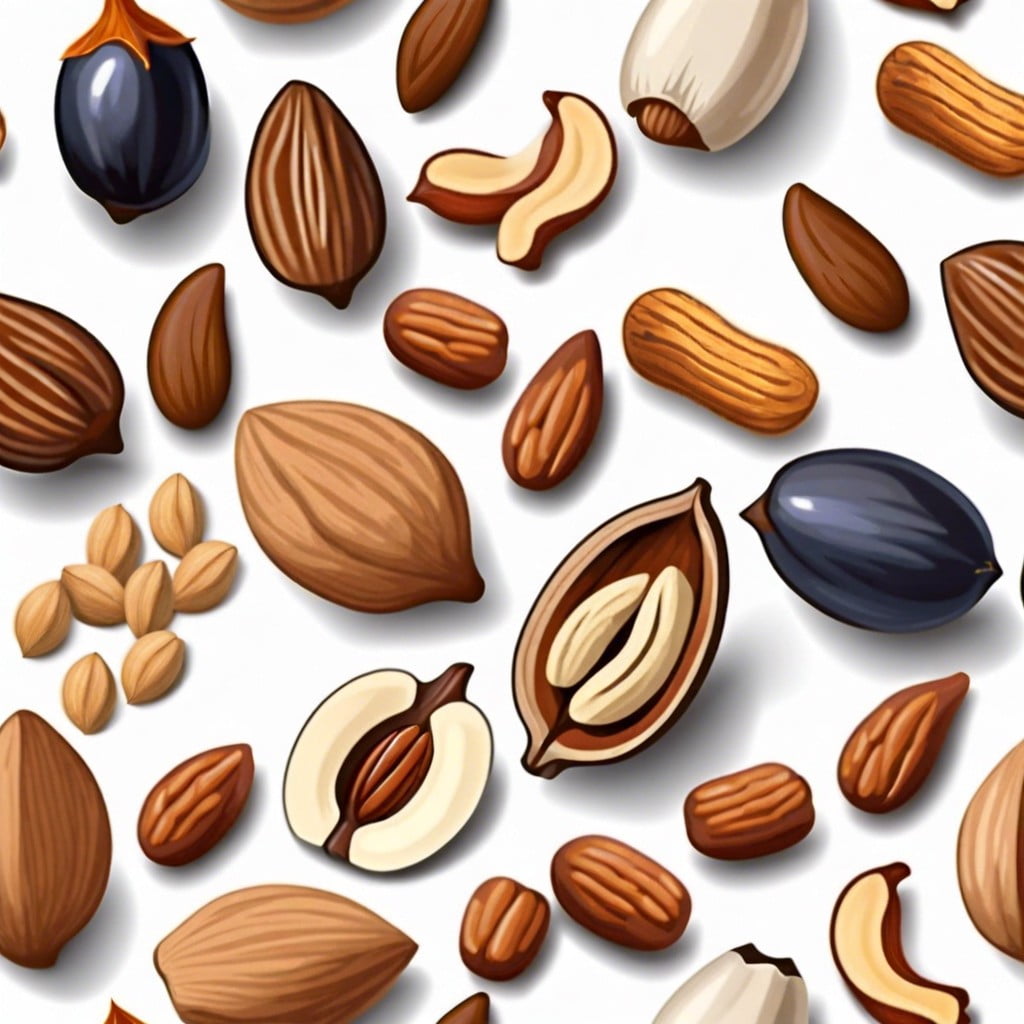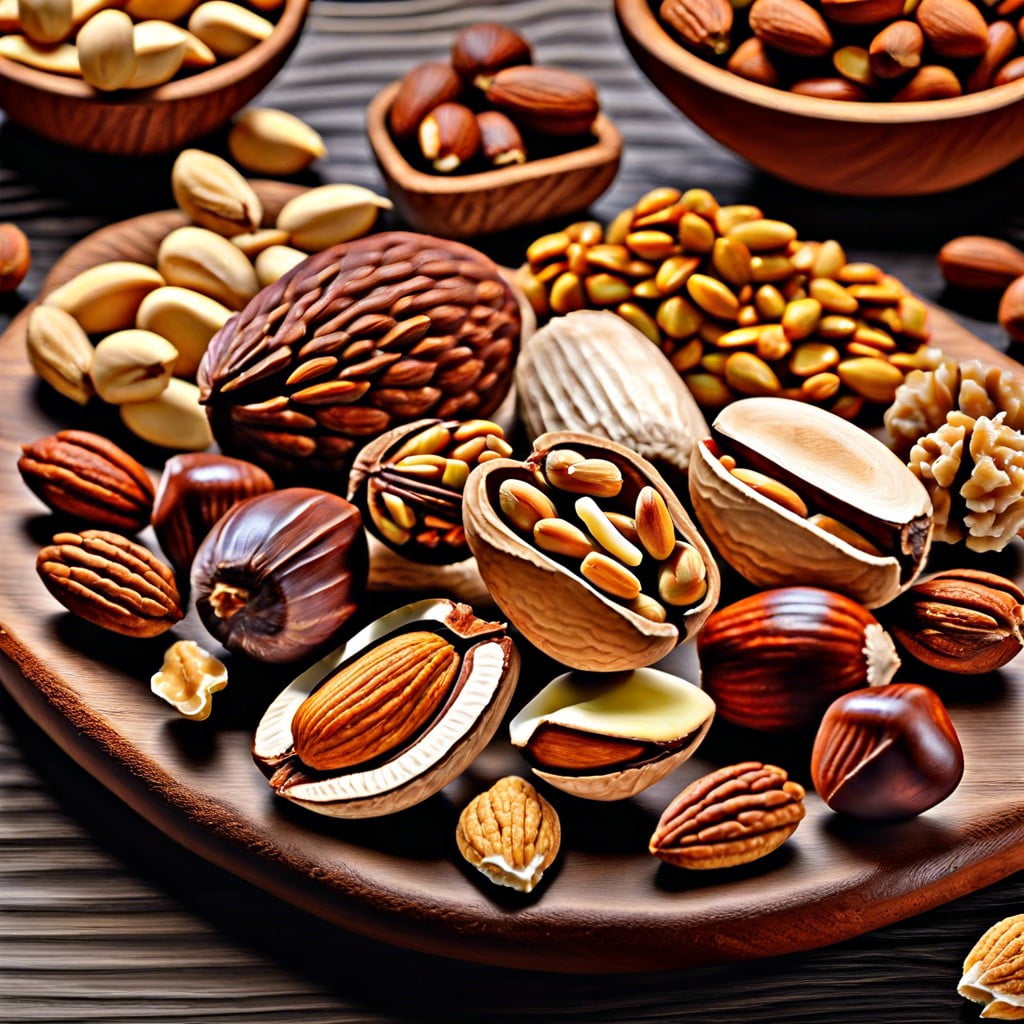Last updated on
Dive into this recipe review because it elucidates the alluring magic of nutty flavors that can surprisingly elevate both sweet and savory dishes.
Key takeaways:
- Nut flavors range from subtle sweetness to bold savory profiles.
- Different nuts have distinct flavor profiles and culinary uses.
- Roasting enhances nutty flavors through chemical reactions.
- Nuts can be paired with both sweet and savory dishes for added texture and flavor.
- Nut allergies can be accommodated with alternative ingredients.
Understanding Nutty Flavors

Nut flavors range from a subtle, sweet whisper to a bold, savory shout, offering an exquisite balance on the palate. Almonds, for example, impart a mildly sweet, almost cherry-like essence, while walnuts present an earthy taste with a slightly bitter edge. Hazelnuts deliver a rich, decadent profile, often paired with chocolate in many desserts. Pecans, with their buttery and sweet nuances, stand out in pies and pastries.
To fully appreciate these flavors, consider the nut’s origin. Climate and soil can influence taste profiles, similar to how terroir affects wine. Furthermore, the freshness of nuts plays a critical role; stale nuts can have a muted flavor or an unpleasant rancidity.
Understanding the complexity of nut flavors not only enhances culinary experiences but also allows for creative experimentation in the kitchen. Whether crafting a sauce that requires a hint of nuttiness or choosing the perfect nut to top a salad, recognizing and leveraging these subtleties can elevate a dish from good to gourmet.
Types of Nuts and Their Distinctive Flavors

Almonds boast a sweet and slightly bitter flavor, often described as cherry-like due to their kinship with stone fruits. They are versatile, enhancing both sweet desserts and savory dishes.
Walnuts carry an earthy and rich taste with a hint of astringency, which tends to mellow out when roasted. Their robust flavor pairs well with hearty salads or baked goods.
Pecans are known for their buttery and sweet profile, with a slightly smoky undertone, making them a favorite in pies and confectionaries.
Cashews have a milder, buttery taste and are commonly used in vegan recipes as a dairy substitute because of their creamy texture when blended.
Hazelnuts are distinct for their sweet, nutty, and rich flavor, popularly paired with chocolate and coffee or used in spreads like Nutella.
Pistachios carry a unique, slightly sweet and savory flavor that stands out in both desserts, such as gelato, and crusted on meats.
Macadamia nuts are prized for their creamy taste and high-fat content, contributing to their luxurious texture, featured prominently in cookies and chocolates.
Brazil nuts have a creamy texture and a rich, earthy flavor, which is quite pronounced, hence their common use in small quantities.
Pine nuts, though small, pack a punch with their buttery, sweet, and resinous flavor, essential in dishes like pesto sauce.
Each nut variety brings its own unique flavor profile to tables and pantries around the world, offering a range of culinary possibilities.
The Role of Roasting in Developing Nutty Flavors
Roasting plays a critical role in transforming the raw, often bland taste of nuts into a rich, more complex, and deeply satisfying flavor profile. The process involves heating nuts to a high temperature, which causes chemical reactions that bring out their natural oils and aroma compounds.
Here’s how roasting enhances the nutty essence:
- Activation of Chemical Reactions: When nuts are heated, the Maillard reaction occurs, which is responsible for browning and developing new flavor compounds.
- Release of Oils: The heat encourages nuts to release their oils, contributing to a more pronounced taste and a pleasing texture.
- Intensity of Flavor: Light, medium, and dark roasts create varying levels of nuttiness, allowing for the customize of flavors to suit different recipes and preferences.
- Aroma Enhancement: As nuts are roasted, they emit a warm and aromatic scent, which is a precursor to the richer flavor that follows.
In practice, roasting times and temperatures should be carefully controlled to avoid burning, which can impart a bitter flavor. Experimentation with roasting can help in discovering the perfect balance to accentuate the natural nuttiness that makes these ingredients a staple in both sweet and savory dishes.
Pairing Nuts With Sweet and Savory Dishes
Integrating nuts into both sweet and savory dishes enhances texture and flavor complexity. Almonds, with their subtly sweet, buttery taste, make a delightful addition to grain salads or as a crunchy topping on yogurt and fruit parfaits. On the savory side, their slivers can adorn a green bean almondine or be ground to thicken and enrich sauces.
For a richer taste, walnuts lend an earthy tone to cheese platters, complement the tang of blue cheese in pear salads, and add depth to caramelized desserts. Pecans, synonymous with Southern cuisine, are a staple in sweet pies and are equally at home spicing up a roasted brussels sprouts dish with their candied form.
Cashews offer a softer bite and a more neutral profile, rendering them ideal for blending into creamy sauces or dairy-free cheese alternatives. They also add an unexpected twist to stir-fries or can be caramelized for a sweet topping on ice cream.
Pistachios, with their vibrant hue and slightly sweet profile, provide a pop of color and flavor when sprinkled over roasted lamb or mixed into a pistachio-crusted cheesecake.
Harnessing the robust, smoky essence of hazelnuts can dramatically transform a simple chocolate spread or gelato, while toasted and chopped, they can serve as a game-changing garnish on fresh salads or pasta dishes.
Understanding the individual flavor profiles of nuts and experimenting with their culinary versatility will surely elevate the experience of any meal.
Popular Nutty Flavored Desserts and Recipes
Almond biscotti serve as a crunchy, dunkable treat ideal with coffee or tea, their almond essence shining through in every bite.
Classic pecan pie, with its gooey, sweet filling, is a staple in Southern cuisine and a testament to the rich flavor that pecans contribute.
For a more delicate dessert, French macarons rely on finely ground almonds to achieve their signature light texture and variety of flavors.
Walnut brownies offer a satisfying contrast with their dense, chocolatey base against the crunch of walnuts.
For those who fancy a spreadable treat, Nutella shows the versatility of hazelnuts as a key ingredient in this chocolaty hazelnut spread beloved worldwide.
Meanwhile, pistachio ice cream showcases how these nuts can lend a subtle flavor and distinct green hue, making it a refreshing and visually appealing dessert option.
Nut Allergies and Flavor Alternatives
For those with nut allergies, the unmistakable richness of nutty flavors can present a significant challenge. However, alternative ingredients can mimic the textural and taste qualities nuts offer:
1. Seeds: Sunflower and pumpkin seeds provide a similar crunch and can take on a toasty flavor when roasted.
2. Nut-Free Butters: Soy nut butter or sunflower seed butter are great substitutes for traditional nut butters in recipes.
3. Roasted Legumes: Chickpeas or soybeans, when roasted, become crunchy and can develop a nut-like flavor.
4. Grains: Toasted oats or buckwheat can also lend an earthy, nutty note to dishes.
5. Safe Oils: For imparting a nutty aroma to dishes, consider refined coconut oil or using culinary argan oil, if not allergic.
6. Herbs and Spices: Some, like fenugreek, offer a maple-like flavor reminiscent of certain nuts when used in moderation.
Careful label reading is crucial for avoiding hidden sources of nuts in ingredients and prepared foods. Consulting with a healthcare provider for personalized advice is also recommended to navigate nut allergies safely.
Storing Nuts to Preserve Flavor
To maintain their distinctive taste, proper storage of nuts is crucial. Cool, dry places away from direct sunlight will prevent nuts from becoming rancid. An airtight container is ideal to keep moisture and pests at bay, which can spoil the nuts.
For longer preservation, refrigeration extends their shelf life to about a year, while freezing can keep them fresh for up to two years. Remember to bring nuts to room temperature before use to fully enjoy their rich, nutty essence.
It’s worth noting that shelled nuts have a shorter shelf life than unshelled ones due to their increased exposure to air. Regularly checking for signs of spoilage, such as a change in color, texture, or a sour smell, will prevent the unpleasant experience of using rancid nuts in cooking.
Nutty Flavor Enhancements: Toasting, Glazing, and Spicing
Enhancing the natural flavors of nuts can transform dishes with depth and complexity. Toasting nuts in a dry skillet or oven tends to deepen their flavor, creating a richer taste and a crisper texture. This method works particularly well with almonds, pecans, and pine nuts, which become more aromatic as their oils heat up and release their essence.
Applying a glaze to nuts is an effective way to add a sweet or savory coating that caramelizes with heat. Typically, a sugar or honey glaze imbues a candied texture, ideal for snack mixes or garnishes on salads and desserts. Alternatively, a soy or maple syrup glaze introduces a unique twist suited for marinades and meat accompaniments.
Adding spices elevates the nuttiness with additional layers of flavor. Cinnamon and nutmeg pair perfectly with sweet dishes, while cayenne or smoked paprika cater to those seeking a savory edge. Incorporating herbs such as rosemary or thyme infuses a fragrant dimension particularly complementary to toasted pine nuts or walnuts.
Experimenting with these techniques allows for customizing flavors to individual tastes and culinary objectives, significantly enriching the gastronomic experience.
The Science Behind Nutty Flavors in Food
Nutty flavors often emerge from complex chemical processes that occur during the roasting and aging of nuts. When nuts are heated, Maillard reactions – a type of non-enzymatic browning – take place. These reactions create a rich tapestry of flavor compounds, including pyrazines that contribute to the warm, toasty essence characteristic of many nut varieties.
Fatty acids within nuts are another crucial factor. Upon exposure to heat, these fats break down into compounds that enrich the nutty aroma and taste. The longer the nuts are roasted, the more intense these flavors become, though too much roasting can lead to bitterness.
The degree of nuttiness can also vary depending on the nut’s origin and how it was processed. Factors such as soil quality, climate, and storage conditions can influence the flavor profile of nuts, adding a layer of complexity to the tasting experience.
In essence, the nutty flavors cherished in culinary practices stem from a synergy of thermal reactions and the intrinsic properties of nuts, inviting both connoisseurs and casual enthusiasts into a world of rich gastronomic discovery.
Health Benefits Associated With Nut Consumption
Nuts are powerhouses of nutrition, offering a variety of health benefits:
Rich in heart-healthy fats: Most nuts contain monounsaturated and polyunsaturated fats, which can help lower bad cholesterol levels, reducing the risk of heart disease.
High in fiber: Fiber promotes digestive health and can aid in weight management by providing a feeling of fullness, which may help reduce overall calorie intake.
Protein-packed: As an excellent source of plant-based protein, nuts are beneficial for muscle repair and growth, particularly for those on vegetarian or vegan diets.
Contains essential vitamins and minerals: Nuts are a source of vital nutrients such as Vitamin E, magnesium, and potassium, all of which play a crucial role in maintaining bodily functions.
Antioxidant properties: Certain nuts, like almonds and walnuts, are rich in antioxidants that help combat oxidative stress and inflammation in the body.
May support longevity: Regular nut consumption has been linked with a decreased risk of certain chronic diseases and may contribute to a longer lifespan.
Including a moderate amount of nuts in the diet can contribute to overall health and well-being, although it’s important to consume them in moderation due to their high caloric density.




